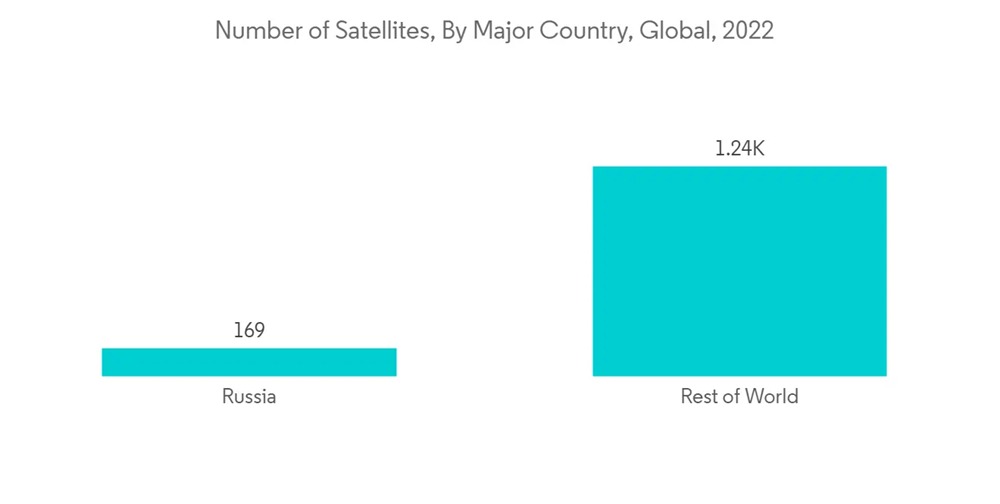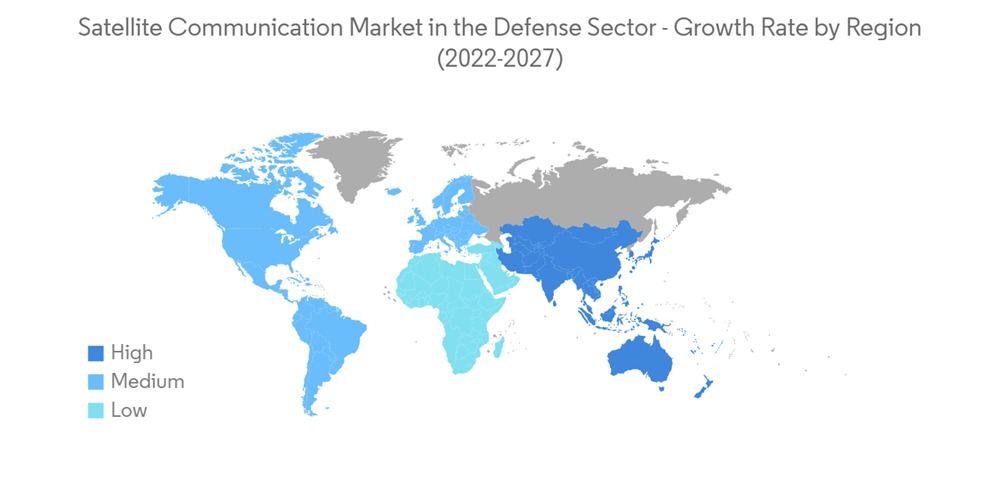Satellite Communication in the Defense Sector - Market Share Analysis, Industry Trends & Statistics, Growth Forecasts 2019 - 2029
Dublin, Ireland, February 28, 2024 - The Satellite Communication Market in the Defense is expected to grow from USD 5.55 billion in 2024 to USD 7.76 billion by 2029, at a CAGR of 6.93% during the forecast period (2024-2029) acording to new research from Reaseach and Markets.
Key Highlights
- Satellite communication is being used for a plethora of applications across the defense industry, an extension of broadband coverage, setting up of 5G communications systems, integration and convergence of diverse wired and wireless technologies, earth observation, defense and security, and surveillance applications.
- The need for broadband communications is growing at a fast pace, and it isn't limited to a single region. Connectivity requirements for users' aboard aircraft, ships, and vehicles operating at fixed places and in motion are examples of such demand. These three platforms require constant connectivity along their travel itineraries, which frequently pass through underserved portions of big cities and less populated areas. Such developments are projected to boost the market's expansion.
- According to the Satellite Industry Association (SIA), ground equipment revenues have increased significantly due to the expansion of GNSS markets and network equipment, while customer equipment investments and resources have remained flat or slightly declining, indicating that mobile satellite communication (MOST) will become a fundamental growth point of the overall market studied.
- Cybersecurity has become a major concern for satellite communication as the entire process of launching a satellite to transmit data is highly sensitive. Further, the challenge lies in the negative impact that such cybersecurity threats can potentially have as the vulnerabilities are mission-critical. The mission-critical vulnerabilities exposed to cybersecurity threats include the launch systems, communications, telemetry, tracking and command, and mission completion. The over-dependency of satellite communication on secure cyber capabilities across the lifespan of the satellite makes it a serious concern, thus, hindering its adoption.
- During the pandemic, communications satellites can be seen providing essential services to freshly deployed field hospitals. Several people were helped by the defense and military during COVID-19. Satellites also provided communication services to ensure business continuity, which was mostly used in self-serve petrol stations, credit/debit card authorizations for retail POS, and inventory management.
Defense Sector Satellite Communication Market Trends
Remote Sensing to Drive the Market
- Remote sensing aids defense, military, and aerospace in providing many types of data. To avoid sinking when a ship hits an iceberg, navigating ships use remote sensing technology such as wind-wave information, routing analysis, ship proximity, and GPS. Many satellites orbit the Earth every day, collecting data that can be useful in locating lost or destroyed aircraft.
- For millennia, remote sensing has been utilized as a surveillance method. Remote sensors were used before the First World War by connecting them to hot air balloons and flying them over target cities. Remote sensing is being carried out by specialized satellites with a wide range of capabilities. Optical satellites, radar imaging satellites, ultraviolet and infrared imagery satellites, and signal intercepting communication satellites are only a few instances.
- Remote sensing offers significant advantages over traditional forms of surveillance in that it may provide high-resolution imagery of light wavelengths other than visible light. This data can also be utilized to track enemy force movements, make strategic decisions, and assess tactical threats.
- The need for greater connection and higher-resolution imaging was beyond the military's ability to meet using military-owned satellite technologies due to the fast growth of science and technology and the dependency of military activities on it. The United States Military, being the world's largest military, has relied largely on commercial satellite capabilities for military purposes since then.
- Furthermore, one of the primary factors driving the satellite communication market growth in the defense sector over the next few years is the application of AI in satellite communication for earth-based surveillance. Furthermore, the rising demand for remote sensing and monitoring applications, as well as governments' plans to establish a network of spy satellites, will drive market demand. Increased seaborne security risks, increased defense sector investments, and growing concerns about political instability in many parts of the world are driving the market.
 |
Asia-Pacific is Projected to Register the Highest Growth Rate
- The region is witnessing various innovations and investments in research and development to strengthen satellite communication in defense organizations. For instance, in December 2021, the Japanese government approved JPY 5.4 trillion (USD 47.2 billion) defense spending for 2022. The funding will also be used to buy new defense equipment.
- Similarly, South Korea is also rigorously strengthening its defense capabilities. In April 2022, The defense program administration of South Korea announced to development of stealth drones, satellites, and other military equipment to address upcoming threats. This plan is a part of the country's policy priorities to enhance its defense and security capabilities. South Korea has allocated KRW 266.4 billion (USD 220 million) to back the development of new stealth drones and military assets.
- India, for example, is one of the largest consumers of satellite programming and has made significant progress in recent years in realizing its full video market potential. Though DTH is immensely popular in India, low-cost options from businesses like Reliance JIO are becoming competitors in the broadcasting space. According to the Telecom Regulatory Authority of India, as of September 2021, there were 68.89 million DTH services subscribers in India; however, this volume is reducing gradually.
- According to the IBEF (Indian Brand Equity Foundation), the Government of India has been attempting to increase the number of airports to accommodate expanding air traffic. India had 153 operating airports as of 2020. By FY40, India plans to increase the number of operational airports to 190-200. Furthermore, the sector's growing demand has increased the number of planes in service. By 2027, the number of aircraft is predicted to reach 1,100.
- As a result of growing investment in in-flight entertainment, the global aviation satellite communication (SATCOM) market is positioned for improved flight operations and connectivity. Countries like India and China are expected to drive the aviation SATCOM market.
 |
Defense Sector Satellite Communication Industry Overview
The satellite communication market comprises several global and regional players, vying for attention in a highly competitive market space due to the presence of many large players. The market poses high barriers to entry for new players, impacting the opportunities to be able to gain traction. This market is characterized by moderate product differentiation, increasing levels of product penetration, and high levels of competition. Generally, the product is offered as hardware, making the offering look like a part of the product's service.
- January 2022 - Thales Alenia Space, a joint venture between Thales (67%) and Leonardo (33%), stated that it had signed a contract with LIG Nex1 Co. Ltd, a South Korean aerospace and defense company, to provide an advanced technology Digital Processor for the GEO-KOMPSAT-3 communications satellite. The Ka-band Flexible Broadband Communication System payload includes an efficient, completely reprogrammable Digital Processor that combines transparent and regenerative signal processing via Digital Channelizer Units (DCU) and On-Board Processing Units (OBPU) portions, respectively.
- January 2022 - Navis Engineering, a dynamic positioning systems manufacturer, announced to offer KVH Watch services to enable remote monitoring of equipment; the company announced that Navis Engineering, maritime dynamic positioning (DP) control system manufacturer, has joined the KVH Watch Solution Partner program to offer KVH watch cloud connect services.
- December 2021 - Inmarsat announced the launch of its first Inmarsat-6 satellite, I-6 F1. It was launched by Mitsubishi Heavy Industries (MHI) from the JAXA Tanegashima Space Center in Japan. The satellites will offer enhanced capacity and new technological advances for ELERA's transformational L-band services, alongside additional Global Xpress (GX) high-speed broadband capacity.
For more information go to: https://www.researchandmarkets.com





